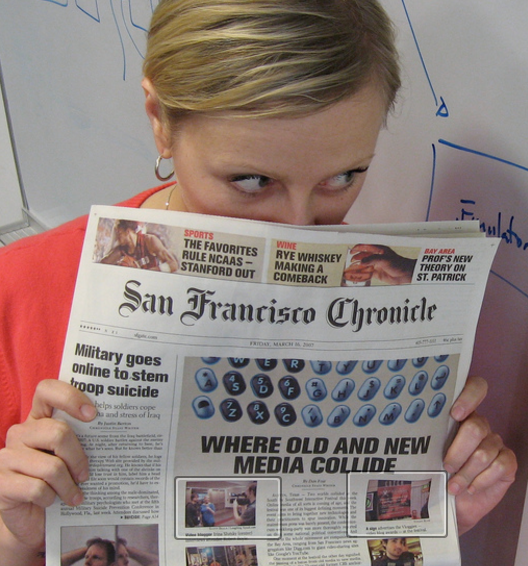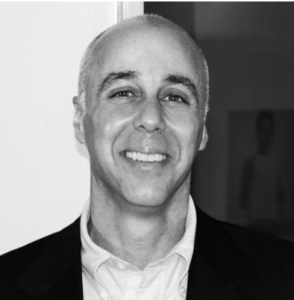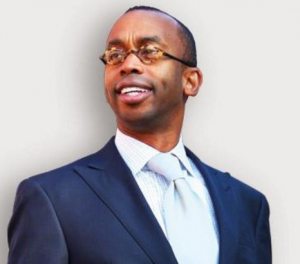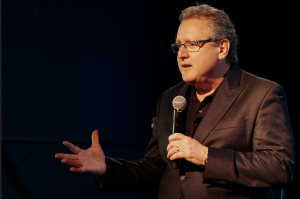
By Mark Schaefer
For the past year or so, I’ve been working on a project I’ve called the “re-invention of the blog.” My vision is to create a space that was more than content … it would also present my ideas in such a beautiful, creative and interactive format that the presentation would be as conversational as the content.
I’m at the point where I actually have a prototype but I’ve been stopped in my tracks because I’ve come to realize that since I started the project, the world has moved rapidly, and dramatically, away from options that would enable me to invest in something this risky and creative — we are in the newsfeed evolution.
In particular, Facebook and Apple are hastening the demise of a publishing industry that is already in trouble by hijacking valuable content for their newsfeeds. In a world where social platforms not only own your content, but your audience and advertising, publishers are scrambling, whether it’s The New York Times or a blogger like me.
To get a view of how some major players are adjusting to this new world of endless free content shoved into little gray newsfeed boxes, I interviewed leading experts from The Economist, W Magazine, Ebony, Foundr, and a rock magazine media group in London. Let’s look at how the world is changing, and what they say this means to you.
The publishing transformation
Twenty years ago, most people subscribed to a paper magazine … maybe a couple. I loved Esquire and National Geographic — a feast for the eyes as well as the mind.
With the dawn of the web, these publications moved to online versions. People still subscribed and the large, bright screens of a desktop computer offered new creative outlets for the content.
Then content moved to apps. This presented a dramatic problem for the artistic look and feel of content. Now, it had to look good on a device that was the size of your hand — in any way you hold it!
But there have been advantages, too. Moving away from paper to electronic versions means:
- Lower production costs.
- Reduced inventory risks.
- Faster, more timely publishing.
- Higher margins for e-versions.
- Broader distribution possibilities.
What’s next: The newsfeed evolution
But if apps were disruptive, the next evolution — content in a newsfeed — throws the foundations of publishing into a buzz saw. In general, people expect content for free, and can’t even be bothered by clicking an app. Many people today want their content organically in whatever newsfeed they prefer … Facebook, Snapchat, Apple News, etc. Even Amazon is getting in on the deal, offering traditional print subscriptions to Prime members.
In these channels, there is little or no art associated with the content. In the blurry stream of Apple News, the content from Esquire looks the same as the content from Sports Illustrated — blocks of gray stuffed into tiny boxes. One analyst even proved that the content display guidelines for many social platforms is literally unreadable. The art of our content is gone, the soul is gone.
And even worse, the subscribers are gone.
To maintain a presence in the newsfeed space, the content must be offered by publishers for free. Subscriptions and ad revenue for most magazines are in a freefall. Facebook and Apple have promised broad exposure for the content that would ultimately increase subscriptions and ad revenue, but it hasn’t worked that way. Why subscribe to anything when there is so much good stuff for free?
Today, publishers say 30 percent of their traffic comes from Facebook, but nearly 60 percent say it’s not creating any revenue.
The demand for continuous free content by Facebook and Apple is crushing the organizations historically known for the best content.
Jeff Bezos, the founder of Amazon and now owner of The Washington Post said subscription content and paywalls are going the way of records in the music industry. People have demonstrated they are unwilling to pay for content.
Bezos said in an interview that he wants to move the Post from “making a relatively large amount of money per reader, having a relatively small number of readers—that was the traditional Post model for decades, avery successful model by the way,” to, “a model where we make a very small amount of money per reader on a much, much larger number of readers.”
Traditional publications like the London Guardian have had massive staff cutbacks to adjust for the revenue shortfalls. Eamonn Store, CEO of The Guardian’s U.S. operations, told staff that the changes were due to low ad sales and to revenue projections that are “not enough to maintain our current cost base.” Store said the company needs to make up for a revenue shortfall of $4.4 million over the next six months.
I was curious as to how mainstream publishers were dealing with the newsfeed evolution, so I talked to five professionals in the publishing industry about how they’re adjusting to the shift.
Here’s what they had to say.
Alex Burrows, Editorial Operations Manager at Team Rock, a publisher of classic rock, metal and blues music magazines
 “It is certainly a very, very challenging time. Facebook is trying to own the news. Publishers are being forced to use Facebook and Apple as a delivery platform because that’s where the audience is today.
“It is certainly a very, very challenging time. Facebook is trying to own the news. Publishers are being forced to use Facebook and Apple as a delivery platform because that’s where the audience is today.
“How successful is our content on Facebook? In a way, that’s up to Facebook. They prioritize what they want to prioritize. Facebook is a necessary evil. We put out content that will have high engagement on Facebook. Hopefully we’ll entice them to check out and visit our website but we haven’t seen meaningful results yet.
“The print subscriptions have been in steep decline, however we are not going to force people online. Many people love paper magazines. They may end up being a labor of love but they will survive. Our readers love the convenience of an online edition but many people love the tactile experience — kind of like vinyl records.
“Our online edition is the music equivalent of an mp3. Some people want to own it and have it available all the time. Publishing on Facebook is the content equivalent of Spotify. It’s basically streaming content and the economics for us are terrible. We don’t think we can run a publishing business relying only on ad revenue from Facebook and Apple.
“Just like any content producer, we are getting creative with our revenue models. We’re creating content partnerships with related products. We have more than 30 years of content available — very valuable. So we’re looking at licensing and other ways to monetize that content. We need to consider very non-traditional revenue streams because the ad revenue might not be there any more.”
![]()
Jeff Pundyk, Senior Vice President, Global Integrated Content Solutions at The Economist
 “The choices you make are driven by the business model. Some publications are dependent on mass reach and advertising, but that’s not our model. We’re trying to reach a very specific audience. Obviously we do need advertising but we are insulated from some of these pressures because we don’t have a need to reach everybody … we need to reach global decision makers.
“The choices you make are driven by the business model. Some publications are dependent on mass reach and advertising, but that’s not our model. We’re trying to reach a very specific audience. Obviously we do need advertising but we are insulated from some of these pressures because we don’t have a need to reach everybody … we need to reach global decision makers.
“In order for us to do that effectively we have to control the environment. We’ve created a thought leader salon. It’s an experience. The magazine was founded in 1863 and if somebody from back then saw it today, it would feel familiar. I think that is an advantage we have … the experience of the content.
“Facebook and Apple News are important ways to spread our reach — to show the world what we’re about — but we’re not dependent on mass audiences or Facebook advertising like some other publications. Whether by great design or by luck, we’re not in the same trouble.
“We understand that our value proposition is our brand. We have built trust and pure editorial content unswayed by sponsors. Every business decision we make is guided by that value.
“I don’t see the print publication going away any time soon. We still have millions of print subscribers and they love it. Even when we talk to millennials they like the print version. It’s a magazine that is ‘finish-able.’ You can sit down, read it, and get a great view of the world in time for your dinner party!
“We are in good shape today because our content is an experience.”
![]()
Abby Silverman, Senior Designer at Condé Nast (W Magazine)
 “Our focus is on fashion, film, and art, and we’re known for the way we present things in new ways. So that is a strong image for us that we maintain on every channel.
“Our focus is on fashion, film, and art, and we’re known for the way we present things in new ways. So that is a strong image for us that we maintain on every channel.
“We have unique content for every platform. We’ll do something for Instagram or Facebook but it will be produced only for those mediums. We’ll create something for Flipboard and something different for Snapchat that does not necessarily lead people back to the magazine. It is simply connecting with those audiences.
“We haven’t jumped into the Apple News stream yet. We are still considering that strategy. It would be a significant effort.
“We have to be all over social because that’s where the people are today. We’re creating a lot of social-specific content. We find that an older audience is still reading the paper version.
“I do feel like there is so much stuff out there and the magazine industry is just producing more and more content aimed at getting views. It is definitely moving away from quality to quantity. In the fashion and beauty space, I just keep seeing the same topics over and over. At W, we are staying focused on quality because that will be the only thing that helps us stand out.
“I’m 26. When I consume content, I want it to be in-feed and organic. I like seeing the content I love within Instagram and Snapchat. I go to apps less and less for news. I still go to blogs because I follow those people on the social channels. It makes me interested in them as a person and I want to learn more about what they have to say.
“In-line and organic — that’s the model everyone will have to serve eventually. You have to be where the people are.”
![]()
Kevin McFall, director of media operations, Ebony magazine
 “We have an important voice in the African-American community and we have maintained a decent print subscription rate. We’re still trying to figure out the digital transition. How do we move from print to a full-fledged media company? How do we make up for the lost ad revenue?
“We have an important voice in the African-American community and we have maintained a decent print subscription rate. We’re still trying to figure out the digital transition. How do we move from print to a full-fledged media company? How do we make up for the lost ad revenue?
“The challenge we face is to have a presence in these new media channels and not cannibalize the content our readers are paying for. We have decades of available content and images that people seek for licensing. Probably an opportunity to focus there.
“We have been a leader in getting our content into Apple News but have not monetized this. To be eligible for monetization, you have to use a special Apple ad format. We have not made that commitment yet. We want to see if we get some traction from the news feed and see what happens before we commit to those changes, which will take some effort.
“When Facebook was promoting publishing via Instant Articles, we tried to move in that direction but frankly it was difficult to get answers from Facebook. It was hard to even get their attention. Facebook has pulled back from the Instant Article direction so our future on Facebook is uncertain. Right now our only real presence is a Facebook page where we feature breaking news, maybe a stand-alone post, or a reference to an article in the magazine.
“We’re in epoch one of our digital transformation. We’re creating awareness in the digital space and weaning ourselves off the dependency on print advertising.”
![]()
Nathan Chan, publisher of Foundr, an online-only magazine
 “Foundr is a magazine devoted to young aspiring entrepreneurs. The focus of the magazine is to show you what it takes to become a successful entrepreneur.
“Foundr is a magazine devoted to young aspiring entrepreneurs. The focus of the magazine is to show you what it takes to become a successful entrepreneur.
“I didn’t have a lot of baggage to get over, or any transition to make. I have no history in the publishing business — I’m an IT guy and I started the magazine four years ago. What I carved out is something that feels right to me.
“Today, you don’t just have a magazine, you don’t just have content, you build a multi-faceted brand. The magazine is a great influence-builder for us but we are constantly re-purposing the content in our podcast, social, blogs, educational courses, premium content for a membership site.
“Our core business is not the magazine. Our core business is the content and being very, very good at leveraging that in different and creative ways. Our new project is taking some of our best content and building it into a beautifully-designed coffee table book that can stand the test of time. We may look at what the Harvard Business Review does in bundling content into short paper and electronic books.
“I agree that Facebook and Apple are taking over content distribution and threatening the direct relationship we have with our readers. So we have to have extra effort to engage with readers and build up our email lists. You need to maintain that direct relationship to succeed. Probably 99 percent of our content is free, so we’d like to have at least 1 percent of our readers buy something.
“I don’t believe we need to be everywhere but we have to master each channel one by one. We have had a lot of success on our blog. It has been the source of a lot of great content. We’ve been seeing success getting exposure on Instagram, now.
“Our strategy is focused on premium, long-form content. We don’t take any shortcuts. And we are being very successful with that.”
![]()
Common themes
Here are some of the key take-aways, which are probably applicable to bloggers, podcasters, and publishers of every size entering the newsfeed evolution:
- Branding is more important than ever. Strong names like The Economist and Ebony command attention in any channel.
- Turning content over to Facebook or Apple not only jeopardizes economic models but also dis-intermediates the direct customer relationship. Publishers need to get creative to find new ways of maintaining a direct connection to their readers.
- Publishing in newsfeeds won’t make up for subscription and ad revenue losses but this is where the new readers will be. A strategy would be to use these channels for brand-building like W, and provide highly-engaging content that would prompt a reader to go back to a website for more.
- Publishers need to shed the idea of having a “publication” and embrace the transition to a multi-faceted, multi-media brand (Examples: A New Orleans newspaper has started a profitable speaker’s bureau for its reporters; The New York Times offered readers a paid event where they could watch election returns with their political reporters).
- New economic models are required that might include licensing and re-bundling evergreen content into new forms.
The newsfeed evolution should be very interesting indeed. What do you think? Have any thoughts for the comment section?
Update: In December 2016 TeamRock declared bankruptcy and folded despite the fact that their site was receiving more than 3 million hits per month. 70 employees were discharged without warning or severance pay.
 Mark Schaefer is the chief blogger for this site, executive director of Schaefer Marketing Solutions, and the author of several best-selling digital marketing books. He is an acclaimed keynote speaker, college educator, and business consultant. The Marketing Companion podcast is among the top business podcasts in the world. Contact Mark to have him speak to your company event or conference soon.
Mark Schaefer is the chief blogger for this site, executive director of Schaefer Marketing Solutions, and the author of several best-selling digital marketing books. He is an acclaimed keynote speaker, college educator, and business consultant. The Marketing Companion podcast is among the top business podcasts in the world. Contact Mark to have him speak to your company event or conference soon.
Illustration courtesy Flickr CC and Irina Slutsky


